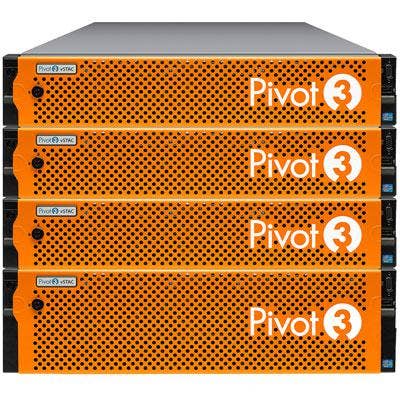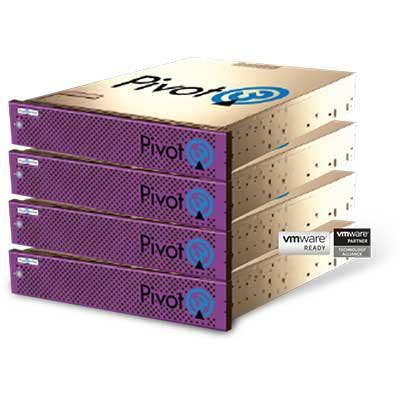CRN Interview: Pivot3 CEO On Besting 'Big Boys' Nutanix, Cisco And Dell While Winning Over Hyper-Converged Channel Partners

Taking On The 'Big Boys'
Ron Nash is bullish about Pivot3's future and competitive edge as hyper-converged infrastructure sales are soaring while its channel base grows.
"It happens all the time in our industry – little smaller companies come up with differential technology and they cannibalize market share of the big boys," said Ron Nash, CEO of the Austin, Texas-based vendor, which was recently named a "Challenger" in Gartner's 2018 Magic Quadrant for Hyper-Converged Infrastructure.
Pivot3's sales increased by more than 65 percent from the first half of 2017 to the second half of the year, due to increased market demand for its high-performance, policy-based Acuity platform, which was launched in April. Its channel base increased by more than 25 percent from the first half of 2017 to the second half with new partners, while deal registrations from the channel increased by nearly 65 percent.
In an interview with CRN, Nash talks about winning against larger competitors like Cisco, Nutanix and Dell, as well as Pivot3's channel strategy and product road map.

You're seeing a spike in new channel partners. Are they coming over from other hyper-converged vendors?
Yes. They are absolutely coming from other hyper-converged companies.
Part of the growth in our business is, a lot of people have bought other companies' hyper-converged platforms and as they grow, get bigger and get more nodes, the background software starts to eat up a lot of the foreground processing. It gets less efficient. We scale linearly. Partners are seeing with some of our competitors that they don't scale linearly. So it's not scaling. They see that grinding down. We are picking up partners who have previously represented our competitors. It is happening.

What's another strategy that's winning over partners?
We have a wedge strategy to getting new partners. So we do video surveillance because of our erasure coding and storage efficiency. For video surveillance, when you have multiple-petabyte files, you can't replicate them – it's cost-prohibitive. Our erasure coding lets you store it very efficiently and it doesn't cost that much. So we kind of have this video surveillance use case ourselves.
Let's say, for example, we show up at the door of a Nutanix partner who says, 'Well I already have a hyper-converged play.' We say, 'OK, we won't challenge you with Nutanix, but are you doing video surveillance?' They would say hyper-converged doesn't really work for video surveillance, but when we explain to them what we do, they pick us up for that specific use case. They start selling us for video surveillance and customers come back and say, 'It's a great platform. I want to put some more applications on it.' The partner sees that, 'Gosh, Pivot3 has a SQL server and this is running faster than Nutanix.' That's the way we've been wedging in to get partners' attention.

How do you compete against IT giants like Cisco, HPE and Dell EMC?
In the IT industry, it happens over and over again – small companies out-innovate large companies. If somebody says, 'I'm a Cisco shop. I always buy stuff from Cisco.' We say, 'Well, would you buy something from Cisco if we can outperform them? It's fine that you get some Cisco hardware to fit in there, or Dell EMC or HPE, but we'll give you 30 days to do a test performance and see what's faster.' So we just say, 'Give us a try and test us.' We win a giant percentage of those that are willing to try.

So that's the same strategy that's working to on-board new channel partners?
Yes. Same thing with partners. We say, 'If you don't want to pick us up and you want to represent Cisco or HPE – go lead with them. But whenever you get in trouble on performance from a customer, just call us.' After we do that two or three times, the partner concludes that they want to lead with us. It happens all the time in our industry – little smaller companies come up with differential technology and they cannibalize market share of the big boys.
You can see it in the Magic Quadrant. There's a cluster of vendors who Gartner ranked with the ability to execute. There's six big, public, giant IT companies. The seventh and final company in that cluster is little old Pivot3. It's the only one up there with them. We got in that group because our performance is better than most of the others up there.

What is Pivot3's hyper-converged technology differentiator?
The big differentiator with us in HCI is performance – that's number one. We had a well-performing product before, but when we put the NVMe data path on there versus going through a controller, it accelerated us significantly – about four to six times faster. Now, you come in via this NVMe card and you can bypass the storage controller. That made a massive difference in our performance. We just run faster than other people. When we go in and a customer needs a certain amount of IOPS or a certain amount of performance, we'll end up getting less processors than our competitors will because we're higher performance, so therefore we're cheaper. Our software can be expensive, but still, the total price to the customer is cheaper.

What's another big hyper-converged technology differentiator?
Another big thing is our system management tool we have to allow the policies different quality of service. So you can say, 'These applications have to have high-priority response times.' It's not a throttling. It's something that just sits and looks over all the processor and what's happening in real time, and allocates and orchestrates different resources to different applications. So it allows you to process a whole bunch of different applications on the same platform and give differential level of services and the correct level of service that each one needs.

What's the technology road map for your Acuity product line?
The big things in store are, we will make it have even higher performance and better management. The big additional thing is looking at us in the cloud. If you are a Fortune 1000 company with lots of applications and IT, they see that if the cloud can give them the performance they need and is economically better – they go to the cloud. If the cloud can't give them the performance, they need to keep it in-house. Some things you just need to keep in-house. We're doing a quality of service layer that goes over all the applications on our platform, we'll be extending that over cloud.

What's the time frame for this cloud innovation push?
This is an overall journey of several years down the road, but you can have an automated way that looks out on these clouds right now. So you can have metrics on what kind of performance you need, what type of data protection you need – we are going to put metrics in our quality of service to show you what kind of economics you need. We'll put the management layer that will manage over the cloud, your on-premise stuff and your legacy stuff. So we'll extend that management layer.
Hyper-converged is a good surrogate for the way the cloud operates and looks. So it will be pretty easy for us to extend our optimization layer that works over hyper-converged out to the cloud. That will be a big boon for people and something they'll need.

What's your channel charge for Pivot3 partners in 2018?
We're in an amazing position right now in a fast-growing market. Growth for us was up 65 percent from the first half [of 2017] to the second half – that's six months growth. If you annualize that, we're growing at over 100 percent. After a lot of years of hard work, you see people like Gartner recognizing us. It's fantastic to get this type level of recognition now. It's always fun to be in a company that's going well. … Things are hopping at Pivot3 and we're having a lot of fun. The channel is critically important for us to succeed, so we're doing everything we can to help partners be successful.